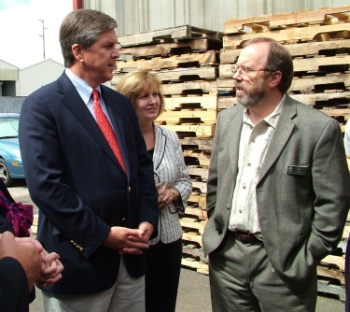
Publisher:
Bonnie King
CONTACT:
Newsroom@Salem-news.com
Advertising:
Adsales@Salem-news.com

~Truth~
~Justice~
~Peace~
TJP
Aug-09-2007 17:10

 TweetFollow @OregonNews
TweetFollow @OregonNews
Food Banks Not Immune To Industry Changes
Salem-News.comA new freezer donated by Senator Gordon Smith should help, but food banks around Oregon are feeling the effects of the economy.
 Senator Gordon Smith, his wife Sharon and Food Bank Executive Director Ron Hays Photo by: Dave Fitzgerald. |
(SALEM, Ore.) - Major changes in the food industry in last 20 years have had extensive impacts on Oregon and our economy. These changes in our farm production, food processing, importing/exporting, available employment, and transportation have also had an effect on Oregon’s food banks and their ability to feed the hungry.
An obvious change is the closure of so many local food industry giants in Marion and Polk counties: Agripac, Agri-Frozen, Birdseye, Chiquita, Norbest, Pictsweet, Seneca, and Smuckers.
The ripple effect of these closures has been immense: layoffs of hundreds of workers (some of whom then needed emergency food assistance); farmers who have had to limit or change the crops they grow; and loss of important corporate donors for food banks, resulting in less food to aid in emergency hunger relief.
The Agripac closure alone meant the loss of the state’s single largest food donor, and more than 1 million pounds of food a year gone from food bank warehouses.
As a result, here in some of the richest farmland in the state, more and more farmers have converted to raising nursery stock or grass seed. Since 1995 in Oregon, over 73,000 acres of local berry and vegetable crops have been lost, while 100,000 acres of seed crops have been added. On top of this, Oregon currently exports almost 45 percent of its agricultural production.
A newer trend, caused by the crisis of rising fuel costs, is taking even more acreage out of food production, as crops are planted and diverted for use in making bio-fuel.
These factors, combined with the availability of inexpensive overseas labor, have resulted in Oregon importing a greater percentage of our food supply. Ironically, the average produce food item on an Oregon grocery shelf has traveled 1,300 to 2,000 miles before it finally reaches the table of an area family.
For food banks, the increased distance from manufacturers means lost opportunities that, in the past, might have resulted in donations of: surplus product, items with labeling errors, packages with a missing or extra ingredient, or foods that waited in storage until a sell-by date made retail distribution impossible.
Further complicating the local emergency food supply, surviving food processors have gravitated toward less expensive specialty packaging and distribution of frozen products in order to compete with cheap imports. This means less availability of donations of shelf-stable, canned products, which are more expensive to produce, but that have made up a majority of food banks’ emergency food supply for decades.
Other industry changes have impacted the hunger relief effort as well. Historically, food banks secured donations of shelf-stable salvage foods--dented cans, crushed packages, etc.--that grocery stores had been tossing in dumpsters. However, increased competition has forced grocers to look for ways to cut losses, and they began selling these items in bulk to salvage food buyers that redistribute the foods to discount markets for resale.
Unfortunately, the public perception that food drives alone can meet the need is wrong. Food drives are important, but the food they generate represents a fraction of what it takes to address hunger that is threatening the health of our people and communities. Since food banks began in the 1960’s, the majority of the supply has come from wholesome food that previously ended up in landfills, and from government relief programs.
As example, 20 years ago to fight local hunger, Marion-Polk Food Share (MPFS) distributed 1.9 million pounds of food. Of that total, 1.3 million pounds--68 percent--were USDA commodities. This year MPFS distributed 4.6 million pounds of food and just over 550,000 pounds--13 percent--were USDA commodities.
With all these changes, one truth is obvious: traditional approaches for addressing the emergency food supply will no longer work in today’s world. Food banks must adapt or--quite literally--fail in their missions.
Like Oregon’s food industry, MPFS is in transition. The new freezer, acquired with the aid of Sen. Gordon Smith, is significant because it means access to the increase in frozen product donations resulting from today’s food processors’ reliance on frozen food distribution as a cost-savings measure.
In addition, MPFS has begun numerous gardens, which added 160,000 pounds of nutritious produce this year. And a new program, “Fresh Alliance,” means MPFS sends refrigerated trucks to grocery stores daily to get meat and dairy products available because they are approaching their sell-by dates. Fresh Alliance netted over 400,000 pounds of wholesome food last year that was quickly distributed to hungry families who, otherwise, would have gone without. Before this program, those foods ended up in landfills.
Focusing on supply is but half the strategy. MPFS will soon be developing and expanding educational programs focusing on teaching budgeting, cooking, nutrition, and canning--all skills designed to help clients make their dollars and food stamps go farther.
Articles for August 8, 2007 | Articles for August 9, 2007 | Articles for August 10, 2007


Quick Links
DINING
Willamette UniversityGoudy Commons Cafe
Dine on the Queen
Willamette Queen Sternwheeler
MUST SEE SALEM
Oregon Capitol ToursCapitol History Gateway
Willamette River Ride
Willamette Queen Sternwheeler
Historic Home Tours:
Deepwood Museum
The Bush House
Gaiety Hollow Garden
AUCTIONS - APPRAISALS
Auction Masters & AppraisalsCONSTRUCTION SERVICES
Roofing and ContractingSheridan, Ore.
ONLINE SHOPPING
Special Occasion DressesAdvertise with Salem-News
Contact:AdSales@Salem-News.com



Terms of Service | Privacy Policy
All comments and messages are approved by people and self promotional links or unacceptable comments are denied.
[Return to Top]
©2025 Salem-News.com. All opinions expressed in this article are those of the author and do not necessarily reflect those of Salem-News.com.